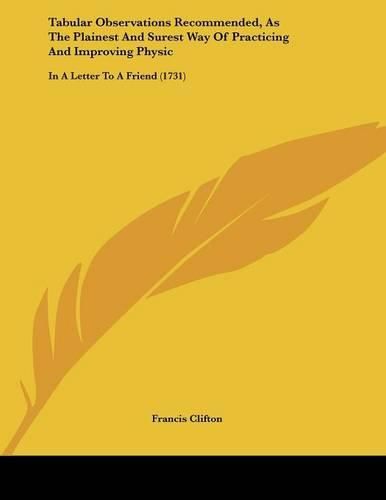Readings Newsletter
Become a Readings Member to make your shopping experience even easier.
Sign in or sign up for free!
You’re not far away from qualifying for FREE standard shipping within Australia
You’ve qualified for FREE standard shipping within Australia
The cart is loading…






""Tabular Observations Recommended, As The Plainest And Surest Way Of Practicing And Improving Physic: In A Letter To A Friend"" is a book written by Francis Clifton and published in 1731. The book is a letter written to a friend, in which Clifton recommends the use of tabular observations as a way to practice and improve the field of medicine. He argues that the use of tables and charts can help physicians organize and analyze data more effectively, leading to better diagnoses and treatments. Clifton provides examples of how tabular observations have been used in the past, and offers practical advice on how to create and use them. The book is a valuable resource for anyone interested in the history of medicine, as well as for modern-day physicians looking to improve their practice.This scarce antiquarian book is a facsimile reprint of the old original and may contain some imperfections such as library marks and notations. Because we believe this work is culturally important, we have made it available as part of our commitment for protecting, preserving, and promoting the world's literature in affordable, high quality, modern editions, that are true to their original work.
$9.00 standard shipping within Australia
FREE standard shipping within Australia for orders over $100.00
Express & International shipping calculated at checkout
""Tabular Observations Recommended, As The Plainest And Surest Way Of Practicing And Improving Physic: In A Letter To A Friend"" is a book written by Francis Clifton and published in 1731. The book is a letter written to a friend, in which Clifton recommends the use of tabular observations as a way to practice and improve the field of medicine. He argues that the use of tables and charts can help physicians organize and analyze data more effectively, leading to better diagnoses and treatments. Clifton provides examples of how tabular observations have been used in the past, and offers practical advice on how to create and use them. The book is a valuable resource for anyone interested in the history of medicine, as well as for modern-day physicians looking to improve their practice.This scarce antiquarian book is a facsimile reprint of the old original and may contain some imperfections such as library marks and notations. Because we believe this work is culturally important, we have made it available as part of our commitment for protecting, preserving, and promoting the world's literature in affordable, high quality, modern editions, that are true to their original work.